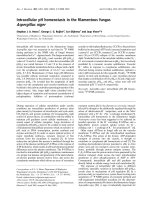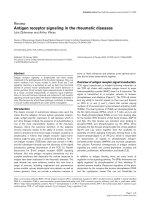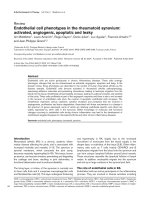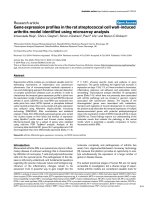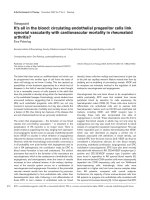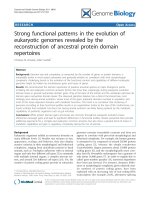Báo cáo y học: " Intramuscular myxoid lipoma in the proximal forearm presenting as an olecranon mass with superficial radial nerve palsy: a case report" doc
Bạn đang xem bản rút gọn của tài liệu. Xem và tải ngay bản đầy đủ của tài liệu tại đây (846.5 KB, 4 trang )
CAS E REP O R T Open Access
Intramuscular myxoid lipoma in the proximal
forearm presenting as an olecranon mass with
superficial radial nerve palsy: a case report
Peter Lewkonia
1
, Shaun AC Medlicott
2
and Kevin A Hildebrand
1*
Abstract
Background: Extremity lipomas may occur in any location, including the proximal forearm. We describe a case of
a patient with an intramuscular lipoma presenting as an unusual posterior elbow mass.
Case presentation: We discuss the case of a 57-year-old Caucasian man who presented with a tender, posterior
elbow mass initially diagnosed as chronic olecranon bursitis. A minor sensory disturbance in the distribution of the
superficial radial nerve was initially thought to be unrelated, but was likely caused by mass effect from the lipoma.
No pre-operative advanced imaging was obtained because the diagnosis was felt to have already been made. At
the time of surgery, a fatty mass originating in the volar forearm muscles was found to have breached the dorsal
forearm fascia and displaced the olecranon bursa. Tissue diagnosis was made by histopathology as a myxoid
lipoma with no aggressive features. Post-operative recovery was uneventful.
Conclusion: We present a case of an unusual elbow mass presenting with symptoms consistent with chronic
olecranon bursitis, a relatively common condition. The only unexplained pre-operative finding was the non-specific
finding of a transient superficial radial nerve deficit. We remind clinicians to be cautious when diagnosing soft
tissue masses in the extremities when unexplained physical findings are present.
Background
Nerve entrapment at the elbow has been described affect-
ing the median, ulnar and radial nerves as well a s their
divisions. Symptoms are variable and depend on the loca-
tion of the lesion and cause of entrapment. Over the past
three decades, radial tunnel syndrome has come to be
recognized as a true clinical entity and surgical treatment
has become more common [1]. One of the rare causes of
compression is a mass lesion such as a parosteal lipoma
which may affect either the radial nerve [2], the superficial
sensory radial nerve [3] or the posterior interosseous
nerve [4]. In these cases, the diagnosis is often delayed and
may be confused with lateral ep icondylitis or other more
common elbow pathologies [5].
Olecranon bursitis is a more common elbow pathology
in the general population which may be either ac ute or
chronic, and in the acute setting may be septic or aseptic.
Chronic aseptic bursitis is rarely treated su rgically, but
some cases which are re sista nt to non-surgical therapies
may require more aggressive treatment with bursectomy,
with or without bony debridement [6]. Pathology in the
olecranon bursa is not expected to cause compression of
the radial nerve or related symptoms due to the distance
between the two structures.
We pre sent here a case in which an intramuscular
myxoid lipoma presented like a chronic aseptic olecranon
bursitis that had failed almost 10 years of conservative
therapy. The diagnosis was made at the time of surgery.
No advanced imaging or further investigation were
obtained pre-operatively. Our patient did describe inter-
mittent paresthesia over the distribution of the superficial
radial nerve. This finding was not well explained pre-
operatively.
Case presentation
A 57-year-old Caucasian right hand dominant ma n pre-
sented with a 10-year history of a progressively enlarging
and mildly tender mass over the bony olecranon of his
* Correspondence:
1
Division of Orthopedic Surgery, Department of Surgery, University of
Calgary, NW Calgary, Alberta T2N 4Z6, Canada
Full list of author information is available at the end of the article
Lewkonia et al. Journal of Medical Case Reports 2011, 5:321
/>JOURNAL OF MEDICAL
CASE REPORTS
© 2011 Lewkonia et al; lic ensee BioMed Central L td. This is an Open Access article distributed under the terms of the Creative
Commons Attribution Li cense ( which permits unrestricted use, distribution, and
reproduction in any medium, provided the original work is properly cited.
right elbow. He had init ially noted the mass without any
previous trauma or pain, and felt the mass was relatively
stable in size. During one acute episode after a fall about
three years prior to presentation, the mass had seemed to
become larger and more bothersome, but was not inves-
tigated further. Over the past two years, the mass had
been somewhat variable in size, but continued to enlarge
slowly. More recently, it had also become mildly tender
and particularly uncomfortable when the elbow was
placed on a table or desk. He did not have a history of
gout or inflammatory arthropathy.
No imaging studies were obtained. Our patient’s family
doctor made the diagnosis of chronic olecranon bursitis.
Two corticosteroid injections were attempted without any
change in symptoms. Eventually, a referral was made to an
orthopedic elbow surgeon. The first examination by the
surgeon revealed a v ague mass over the olecranon, mea-
suring approximately 3 × 3 cm. There were no skin
changes, and no excessive warmth or erythema to suggest
infection. A neurovascular examination demonstrated
some decreased sensation to pinprick over the dorsal first
web space of the affected hand, with full motor power in
the distribution of all major nerves including the radial
and posterior interosseous nerves. No other sensory defi-
cits were identified.
Our patient chose to continue observing the mass. At a
follow-up appointment about six months later, the deci-
sion was made to proceed with surgical treatment with
excision of the olecranon bursa for presumed chronic
aseptic olecranon bursitis. At that time, the sensory deficit
in the hand had almost completely resolved. No further
imaging or investigation were pursued.
At the time of surgery, a standard posterior approach to
the olecranon bursa was employed. Upon dissection
through the subcutaneous tissues, the olecranon bursa was
identified but was found to be displaced proximally and
superficially by an encapsulated mass extending from the
fascia to the lateral side of his proximal do rsal ulna. The
capsule was fibrous and easily separated from the subcuta-
neous tissue although it was inseparable from his dorsal
forearm fascia. A yellow, uniform fatty mass was found to
be protruding through a defect in his dorsal forearm fascia
originating within the most proximal portion of the exten-
sor group. There was no invasion of the local muscle tis-
sue and his elbow capsule was intact and uninvolved.
Histopathological examination confirmed the diagnosis
of a lipoma (Figure 1) with myxoid change (Figure 2) and
no evidence of malignancy. Post-operative examination
confirmed a normal neurovascular examination with no
recurrence of paresthesia and normal power in all muscle
groups in his upper extremity. Our patient maintained a
full range of motion of his elbow and forearm.
Discussion
There were several unusual features of this case compared
to other reports of proximal forearm or peri-articular
Figure 1 High-power (200×) H&E stain of benign lipoma tissue from the surgical specimen. Typical adipocytes with no evidence of
malignant change.
Lewkonia et al. Journal of Medical Case Reports 2011, 5:321
/>Page 2 of 4
lipomas. The neurologic symptoms were intermittent and
not considered pre-operatively to be related to the poster-
ior elbow mass. There are several described cases of paros-
teal or intramuscular lipomas in a similar location,
presenting with moderate to severe elbow pain and well
defined symptoms affecting either the superficial radial
nerve [3] or posterior interosseous nerve [4]. In these
cases, the mass itself was contained within a fascial cover-
ing. Presumably, the mass effect became more pronounced
over time as the slow-growing lesion increased the pres-
sure on the adjacent nerve. With the case presented here,
the fascia was violated. This structural abnormality may
have prevented increasing pressure on the superficial
radial nerve, and instead resulted in a moderately bother-
some posterior elbow mass.
In the clinical setting, olecranon bursitis is a common
and benign diagnosis that has few specific features to
accurately distinguish it from any other soft tissue mass.
Both bursitis and non-aggressive soft tissue masses may
be present with minimal symptoms for many years
before presenting to a surgeon after having failed con-
servative or non-surgical therapy. This case reminds
bot h primary health care providers as well as specialists
that in cases where unusual clinical findings are also
present, further imaging or other investigation may be
necessary to make appropriate treatment or surgical
plans.
Conclusions
To the best of our knowledge, this is the first report of
a lipoma extending through the posterior fascia cover-
ing the extensor compartment presenting as a posterior
elbow mass. In this case , the unexplained numbness in
the distribution of the superficial radial nerve could
very plausibly have been caused by a compressive neu-
ropathy by the lipoma as the nerve passed radial to the
brachioradialis.
Consent
Written informed consent was obtained from the patient
for publication of this case report and any accompany-
ing images. A copy of the written consent is available
for review by the Editor-in-Chief of this journal.
Author details
1
Division of Orthopedic Surgery, Department of Surgery, University of
Calgary, NW Calgary, Alberta T2N 4Z6, Canada.
2
Department of Pathology &
Laboratory Medicine, University of Calgary, NW Calgary, Alberta T2N 4Z6,
Canada.
Authors’ contributions
PL reviewed the available literature, and drafted the manuscript. SM
provided the microscope images and provided background information
regarding myxoid lipomas. KH assisted with critical review of the manuscript.
All authors read and approved the final manuscript.
Competing interests
The authors declare that they have no competing interests.
Figure 2 High-power (100×) H&E stain of myxoid degeneration within benign lipoma. A dipocytes (blue arrow) interspersed with
deposition of mucin-like tissue (red arrow).
Lewkonia et al. Journal of Medical Case Reports 2011, 5:321
/>Page 3 of 4
Received: 23 November 2010 Accepted: 20 July 2011
Published: 20 July 2011
References
1. Lawrence T, Mobbs P, Fortems Y, Stanley JK: Radial tunnel syndrome. A
retrospective review of 30 decompressions of the radial nerve. J Hand
Surg Br 1995, 20(4):454-459.
2. Lidor C, Lotem M, Hallel T: Parosteal lipoma of the proximal radius: a
report of five cases. J Hand Surg Am 1992, 17(6):1095-1097.
3. Chung-Yuh T, Tu-Sheng L, Chen IC: Superficial radial nerve compression
caused by a parosteal lipoma of proximal radius: a case report. Hand
Surg 2005, 10(2-3):293-296.
4. Ganapathy K, Winston T, Seshadri V: Posterior interosseous nerve palsy
due to intermuscular lipoma. Surg Neurol 2006, 65(5):495-496.
5. Moss SH, Switzer HE: Radial tunnel syndrome: a spectrum of clinical
presentations. J Hand Surg Am 1983, 8(4):414-420.
6. Stewart NJ, Manzanares JB, Marrey BF: Surgical treatment of aseptic
olecranon bursitis. J Shoulder Elbow Surg 1997, 6(1):49-54.
doi:10.1186/1752-1947-5-321
Cite this article as: Lewkonia et al.: Intramuscular myxoid lipoma in the
proximal forearm presenting as an olecranon mass with superficial
radial nerve palsy: a case report. Journal of Medical Case Reports 2011
5:321.
Submit your next manuscript to BioMed Central
and take full advantage of:
• Convenient online submission
• Thorough peer review
• No space constraints or color figure charges
• Immediate publication on acceptance
• Inclusion in PubMed, CAS, Scopus and Google Scholar
• Research which is freely available for redistribution
Submit your manuscript at
www.biomedcentral.com/submit
Lewkonia et al. Journal of Medical Case Reports 2011, 5:321
/>Page 4 of 4


